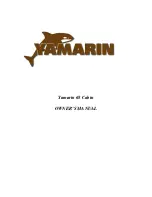
11
the Colorado 450 infl atable boat does not require any licen-
ce provided that the people who operate the boat know the
techniques of small boat operation within the scope necessary
for its operation, as well as the valid navigation rules of the
particular country.
The design of Colorado 450 enables the boat to be used on
wild water up to Diffi culty Grade WW 4 or for waterbased
tourism activities on calm rivers. The boat's advantages are
good stability, manoeuvrability, space-savings, easy transport
and a long lifetime. The boat is propelled by paddlers sitting in
their seats or on sidewall cylinders. All people in the boat have
to wear fl otation life-jackets. Use long canoe paddles. When
using the boat on wild water, feet should be fi xed in foot straps,
which enable safe abandonment of an overturned boat.
ATTENTION
Prior to every use of the boat, check whether it is nece-
ssary to observe any special regulations, restrictions or
rules connected with the river, surface of water or area in
which you aim to operate.
The boat is not designed to be towed behind motorboats,
nor may it be towed otherwise, dragged or in any way
stressed unusually. Sharp edged and pointed items ca-
rried in the boat must be safely wrapped.
Place all precious items into a waterproof container and
fasten it to the boat.
Over time, sunlight adversely aff ects the rubber coating
of the boat; therefore, it is advisable to store the boat in
shade each time after use.
CAUTION
•
On large surfaces of water (seas, lakes) pay attention
to water currents and off -shore breezes. Currents and
breezes may make it impossible to return to shore.
•
The Colorado infl atable boat should not be used in
challenging conditions, such as in reduced visibility
(night, fog, rain).
•
It is necessary to suffi
ciently practise abandoning
an overturned boat on calm waters in advance.
Characteristics of Di
ffi
culty Grade WW 4 – Very Hard:
•
Big rapids, waves, pillows, whirlpools and strong blockage;
inspection of the river sections to be taken is recommended.
Subjective assumptions for riding wild waters graded
WW 4:
•
Excellent knowledge of techniques and tactics for riding
wild waters. The ability to realistically evaluate the di
ffi
culty
posed and the actual state of the river's waters. Knowledge
of live-saving techniques in the water and swimming skills
in wild waters. Physical and mental toughness.
Technical equipment:
•
Covered boats or boats with self-draining
fl
oor;
fl
otation life-
-jackets with a minimum displacement of 7.5 kg, helmets,
protective clothes against cold (neoprene) and safety in-
struments.
ATTENTION
Pay great attention to your choice of fl otation life-jacket.
The fl otation life-jacket should have a tag bearing details
of its fl otation capabilities and safety certifi cation.
2. Technical Description
1. side drum
2. bottom
3. front deck
4. rear deck
5. infl atable seat
6. PUSH/PUSH valve – for infl ation/defl ation, pressure cont-
rol and pressure measuring by manometer
7. overpressure valve
8. feet fi xture
9. infl atable seat fi xture
10. safety rope fi xture
11. safety rope
12. yellow Warning label
13. manufacturer’s label
14. anchor rope fi xture
ACCESSORIES SUPPLIED WITH THE BOAT
Transport bag, two compression straps for the compression
of the folded boat, user’s manual with warranty card, foam
sponge, gluing kit containing the glue, patches, valve adapter.
3. Inflation Instructions
Unfold the boat. Lace the infl atable seats to the boat by the
rope. (Please note that each seat has diff erent dimensions.
They are laced in order from the bow: 91 cm, 96 cm, 91 cm.)
Infl ate the air chambers in the following order: side drum (1),
bottom (2), front deck (3), rest deck (4) and seats (5). For the
infl ation it is favourable to use a foot pump or piston pump with
using the valve adapter – see Fig. 2b (the adapter is a part of
the gluing kit). Before the start of infl ating, check the conditi-
on of the valves. Set the valves to the Closed position. For
the way of operation of the valve see Fig. 2. Infl ate the air
chambers until they are fi rm but not completely stiff . The air
chambers should provide a feeling comparable to squeezing
a ripe orange. You can check the exact operating pressure by
using a suitable pressure gauge (optional accessory) – see
Figure 2a. The wrench for the installation of the valve – see
Fig. 2c – is an optional accessory.
ATTENTION
The maximum operational pressure in the air chambers
is 0.02 MPa. If the ambient temperature increases (e. g.
owing to sunlight), the pressure in the air chambers of
the boat can rise rapidly. We recommend releasing some
air from all air chambers of the boat after pulling it out of
the water. Possible destruction of the air chambers will
thus be prevented.
However, do not forget to continuously monitor the air
pressure in the chambers afterwards, too. A correspon-
ding reduction in operating pressure is up to 20% within
24 hours.
ATTENTION
When using the boat, always seal the valves with their
valve caps. This will keep dirt out of the valves. Dirt can-
cause leaky valve seals.
4. Using the Boat
Colorado 450 is a six-seat boat with open stern designed
for water tourism. Whenever the boat is used on waterways,
Waterway Traffi c Rules have to be observed. Operation of












































